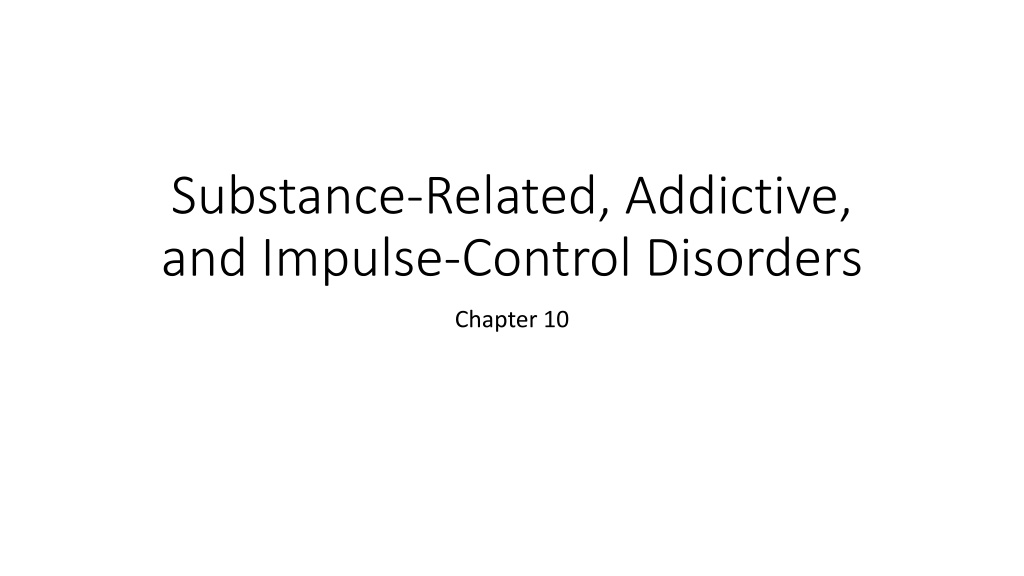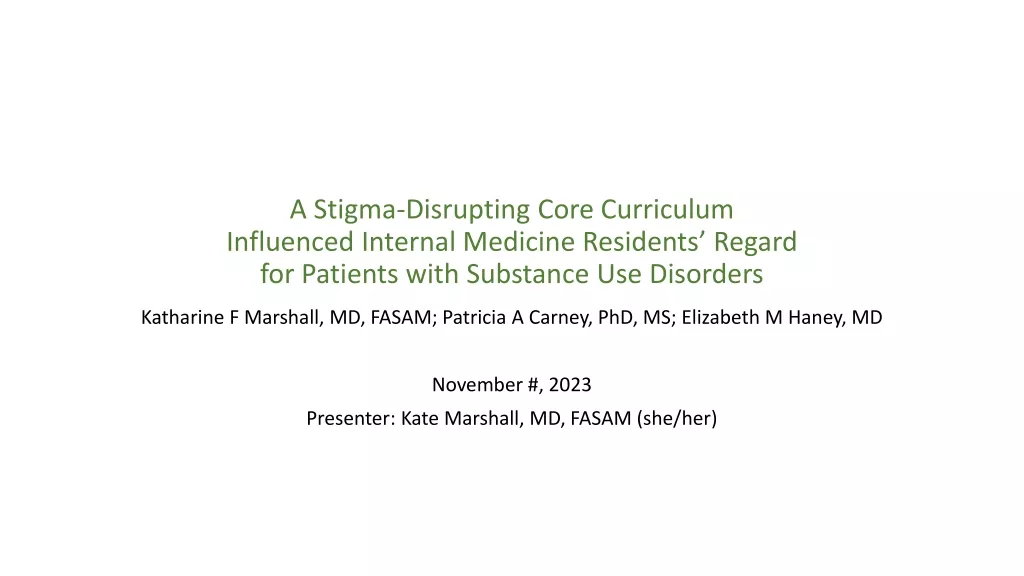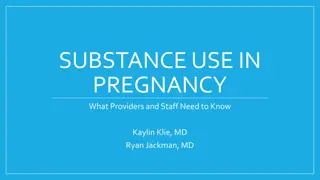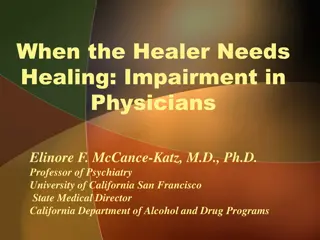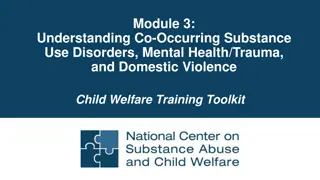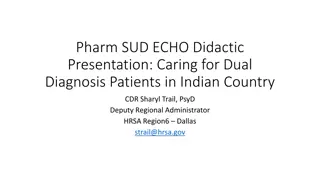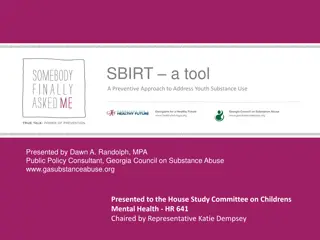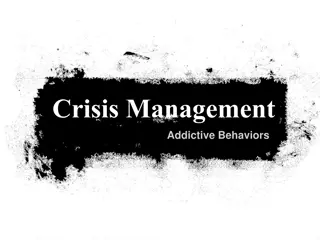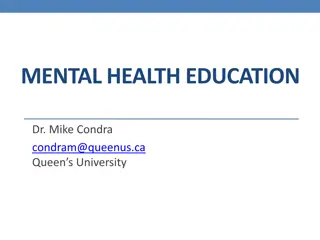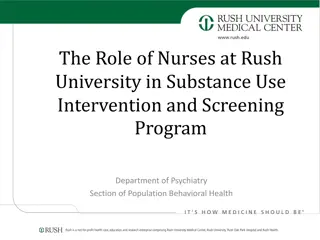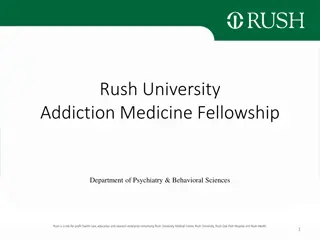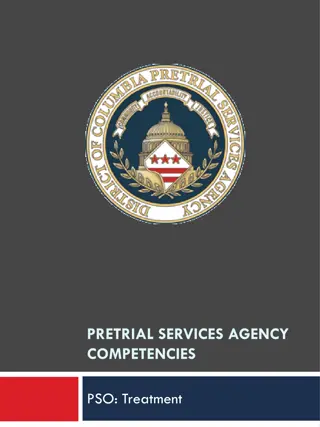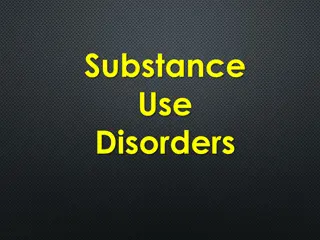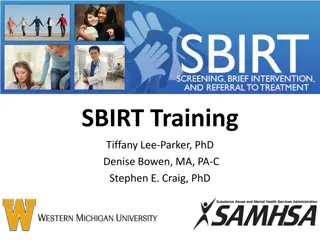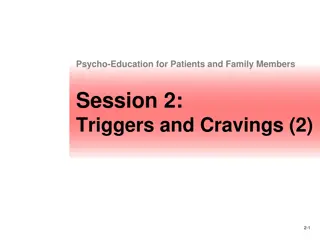Understanding Substance-Related and Addictive Disorders
This chapter delves into Substance Use, Intoxication, Substance Abuse, Addiction, Withdrawal, and Psychological Dependence. It explores the varying levels of severity in substance-related disorders and the distinction between physiological and psychological reactions to drugs.
Download Presentation

Please find below an Image/Link to download the presentation.
The content on the website is provided AS IS for your information and personal use only. It may not be sold, licensed, or shared on other websites without obtaining consent from the author. Download presentation by click this link. If you encounter any issues during the download, it is possible that the publisher has removed the file from their server.
E N D
Presentation Transcript
Substance-Related, Addictive, and Impulse-Control Disorders Chapter 10
Substance Use Ingestion of psychoactive substances in moderate amounts that does not significantly interfere with social, educational, or occupational functioning Drinking coffee, smoking a cigarette, having a drink Occasional ingestion of illegal drugs
Intoxication Physiological reaction to ingested substances- being drunk, getting high Impaired judgement, mood changes, lowered motor ability
Substance Abuse Not necessarily how much Significant interference- disrupts education, jobs, relationships, puts you in a physically dangerous situation A pattern of use Drug use can predict later job outcomes
Addiction AKA Substance dependence Physiological dependent on drug Requires increasingly greater amounts of the drug to experience the same effect (Tolerance) Will respond in a negative way when the substance is no longer ingested (Withdrawal) Tolerance and Withdrawal are physiological reactions to the chemicals being injested
Withdrawal Headaches can be caffeine withdrawal if you are used to drinking coffee regularly (if you drink coffee will it go away?) Alcohol can cause delirium (hallucinations and body tremors) Many substances- chills, fever, diarrhea, nausea and vomiting, aches and pains
Withdrawal Not all substances are physiologically addicting You would not go through withdrawal when you stop taking LSD Cocaine- anxiety, lack of motivation, and boredom Cannabis- nervousness, appetite change, sleep disturbance
Psychological Dependence Behaviors drug-seeking Repeated use, desperate need to ingest more (stealing money, standing outside in the cold), likelihood that use will resume after a period of abstinence Different than physiological reactions Old DSM- substance abuse and substance dependence Combined in DSM5- now substance-related disorders with levels of severity (mild- 2 or 3/11 criteria, moderate- 4 or 5/11 criteria, or severe- 6 or more/11 criteria)
Does drug use lead to addiction We cannot predict who may be more likely to lose control and abuse drugs/ likely to become dependent with passing use Some people use occasionally and are fine (even harder drugs) Some use only once/a few times and have a problem
Dependence versus Abuse Dependence can be present without abuse Cancer patients may become dependent on morphine for pain- build up tolerance and go through withdrawal if it is stopped
Comorbidity of people in addiction treatment have an additional psychiatric disorder More than 40% have mood disorders Anxiety/PTSD in more than 25% Do they symptoms exist outside the realm of substance use- are symptoms seen during drug use or within withdrawal period or did they exist before use and continue after withdrawal period would have passed
Types of substances- 6 categories Depressants- behavioral sedation: etoh, barbiturates, and benzos Stimulants- cause us to be more active/alert and elevate mood: amphetamines, cocaine, nicotine, caffeine Opiates- produce analgesia (pain reduction) and euphoria: heroin, opium, codeine, and morphine Hallucinogens- alter sensory and perception and can produce delusions, paranoia, and hallucinations: cannabis and LSD Other Drugs of Abuse- psychoactive effects: inhalants, anabolic steroids, other over-the-counter and prescription meds such as nitrous oxide Gambling disorder- unable to resist urge causing negative consequences
Depressants Decrease CNS activation Reduce physiological arousal, help us relax Etoh, sedative, hypnotic, and anxiolytic drugs, those prescribed for insomnia Wernicke-Korsakoff syndrome: confusion, loss of muscle coordination, and unintelligible speech- thiamine deficiency which is a vitamin metabolized poorly by heavy drinkers Fetal alcohol syndrome- fetal growth retardation, cognitive deficits, behavior problems, and learning difficulties; characteristic facial features
Binge Drinking 5 or more drinks on the same occasion (23% of the population in the past month). Tailgating 42% of college students had gone on binge of heavy drinking once in the preceding 2 weeks GPA of A- no more than 3 drinks per week GPA of D and F- average of 11 drinks per week
Drinking Drinking at early age (11-14 yoa) predictive of later alcohol-related disorders Individuals who tend not to develop slurred speech, staggering, and other sedative effects are more likely to abuse it in the future Mixing energy drinks may be problematic- reducing sedative effect may lincrease liklihood of later abuse Violent behavior? Chicken or the egg, reduced impulse control, impaired ability to consider consequences
Sedative, hypnotic, anxiolytic Barbiturates (Amytal, Seconal, Nembutal) and Benzodiazepines (Valium, Xanax, Ativan) Influence GABA Barbs- help people sleep and replace etoh and opium Benzos touted as miracle cure for anxiety Benzos considered safer than Barbs- less risk of abuse and dependence However- rohypnol (roofies) same effect as alcohol without odor
Barbiturates Relax muscles Feelings of well-being Slurred speech Problems walking, concentrating, and working Diaphragm muscles can relax so much that they cause death by suffocation Common means of suicide
Benzodiazepines Calm Induce sleep Muscle relaxants Anticonvulsants Pleasant high, reduction of inhibition Tolerance and dependence can develop Withdrawal like etoh- anxiety, insomnia, tremors, delirium
Stimulant-Related Disorders Amphetamines Elation and vigor Reduce fatigue Feel up Followed by crash , feeling depressed or tired Created in lab- asthma and nasal decongestant Weight loss due to reduced apetite Use for pulling all-nighters, energy boost to stay awake (truck drivers, pilots, students) Ritalin, Adderall used for ADHD 2/3 of college students in their 4thyear had been offered illegal prescription of stimulants, 31% used them (studying)
Intoxication Euphoria or affective blunting Changes in sociability Interpersonal sensitivity Anxiety Tension Anger Stereotyped behaviors (repetitive body movements) Impaired judgment Impaired social/occupational functioning
Physiological changes Heart rate and blood pressure changes Perspiration or chills Nausea or vomitting Chest pain Seizures coma
Severe intoxication/overdose Hallucinations Panic Agitation Paranoid delusions Tolerance builds quickly making it especially dangerous Withdrawal- apathy, prolonged periods of sleep, irritability, and depression
Designer drugs MDMA (appetite suppressant) now used recreationally (Ecstasy) After methamphetamine MDMA club drug most often bringing people to emergency room, passed LSD in frequency of use Methamphetamine (Crystal Meth or Ice)- purified crystallized form of amphetamine; ingested through smoking Aggressive tendencies Stays in system longer than cocaine making it particularly dangerous Potential for dependence is extremely high MDMA can cause lasting memory problems
Cocaine Derived from leaves of the coca plant Increase alertness Produces euphoria Increases blood pressure and pulse Causes insomnia and loss of apetite Short lived Cocaine induced paranoia- 2/3 or more of users Causes heart beat to become rapid and irregular- can have fatal consequences Crack cocaine is a crystallized form of cocaine that is smoked Dependence sneaks up on you- thought of as wonder drug at first; tolerance and withdrawal do happen May result in premature aging of the brain Withdrawal- apathy and boredom, particularly dangerous; atypical; brings you back to life
Tobacco 20% of all people in the US smoke down from 42% in 1965 Withdrawal- depressed mood, insomnia, irritability, anxiety, difficulty concentrating, restlessness, increased appetite and weight gain Nicotine stimulates CNS: can relieve stress and improve mood Can also cause high blood pressure, increase the risk of heart disease and cancer High doses: blur vision, cause confusion, lead to convulsions, sometimes cause death Relapse equal among- etoh, heroin, and cigs
Caffeine Most common of psychoactive substances- 90% of all Americans Gentle stimulant- least harmful of addictive drugs Can still be problematic High levels in pills or energy drinks: some are banned in certain countries Elevate mood, reduce fatigue Large doses- jittery, insomnia Takes about 6 hours to leave body- sleep disturbance Pregnancy- 1 cup a day is ok Withdrawal- headaches, drowsiness, unpleasant mood
Opioids Natural opiates Synthetic (heroin, methadone, hydrocodone, oxycodone Natural (enkephalins, beta-endorphins, dnorphins Euphoria, drowsiness, slowed breathing Death if respiration is completely depressed Analgesics- relieve pain Withdrawal very bad- makes stopping hard: 6-12 hours- yawning, nausea/vomiting, chills, muscle aches, diarrhea, and insomnia 1-3 days, withdrawal process completed in about a week
Heroin a million people, double the number in 2007 Most common abused opiate Illicit use of opioid containing prescription meds has risen- 12% of high school seniors used opioids for nonmedical reasons 80 addicts- 22% had died (overdose and suicide); of those that survived- 80% were no longer using, 20% were being treated with methadone
Cannabis Most routinely used illegal substance 5-15% of people in western countries reporting regular use Mood swings, normal experiences seem extremely funny, dreamlike state in which time seems to stand still, heightened sensory experiences, vivid colors, appreciating subtleties of music More than other drugs- different reactions in people First use- often no reaction, high can be turned off if motivated Can also change to paranoia, hallucinations, and dizziness
Cannabis cont Impairments in memory, concentration, relationships with others, employment Though what came first- psychological problems may precede use Synthetic marijuana (K2, spice)- can be purchased legally- hallucinations, seizures, heart rhythm problems Contradictory evidence for tolerance: tolerance to high or increased high with use Irritability, restlessness, appetite loss, nausea, difficulty sleeping
Medical Marijuana Successful use of cannabis and by-products for certain diseases Chemo-induced nausea and vomiting HIV-associated anorexia Neuropathic pain in MS Cancer pain Carcinogens
Hallucinogens LSD (acid): most common hallucinogen, synthetic Natural- psilocybin (mushrooms), mescaline (peyote) Phencyclidine (PCP)- snorted, smoked, injected; causes impulsivity and aggressiveness Perceptual changes such as subjective intensification of perceptions, depersonalization, hallucinations Pupillary dilation, rapid heartbeat, sweating, blurred vision
Hallucinogens cont Tolerance develops quickly; if repeat use over a period of days they lose effectiveness; sensitivity returns a week after abstinence No withdrawal Psychotic reactions- e.g., jump out windows because think you can fly bad trips paranoia
Positive and Negative Reinforcement Gives pleasure, takes away pain/stress Cope with unpleasant feelings Opponent-process theory- Motivation shifts once tolerance and withdrawal build: Starts with trying to achieve a high, ends with trying to decrease the negative consequence of crash : that is why the neg part doesn t lead to decrease The very drug that is making you feel bad is also the one thing that can take away the pain: enslaved by the cycle
Cravings Availability Contact with paraphernalia Moods Small doses of drug VR can be used Changes in the brain (neuroplasticity) increase drive to obtain and use Self-medication Genetic influences
Treatment Biological treatment- agonist substitution (methadone ad buprenorphine); nicotine gum, patch, etc tappered off Antagonist drugs- block the effects of the drug, produces withdrawal (must be free from withdrawal before starting naltrexone), removes high so must be motivated Aversive treatment- Antabuse: causes nausea, vomiting, and elevated heart rate and respiration if you drink
Treatment Psychosocial treatment- Inpatient AA- 12 step program; alcoholism is a disease, more powerful than individual, higher power needed to overcome, destigmatizing, social support, total abstinence Controlled use Component treatment- package- covert sensitization, contingency management, community reinforcement, Motivational Enhancement Therapy- empathetic and optimistic counseling, core values, positive outcome expectancies CBT
